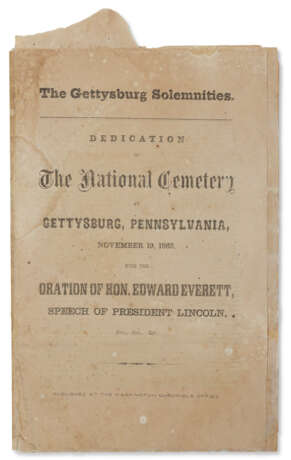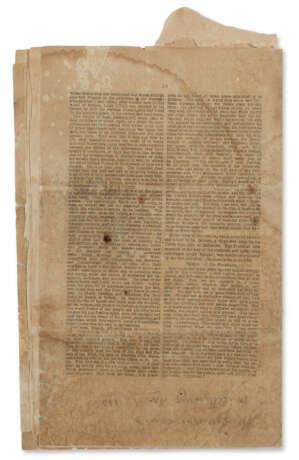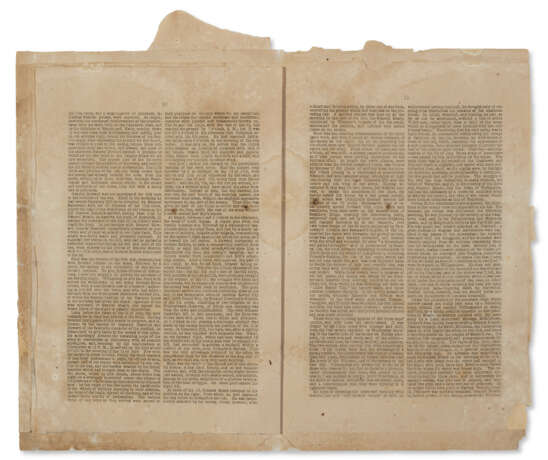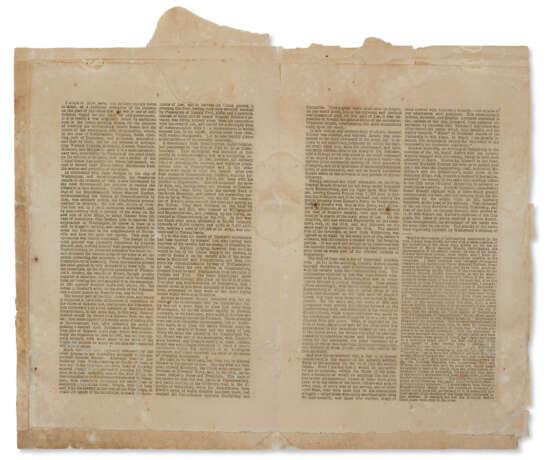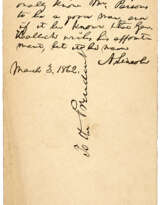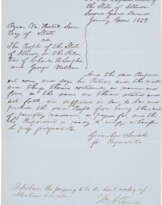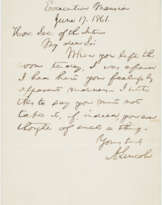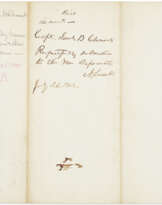ID 887974
Lot 196 | The Gettysburg Address
Estimate value
$ 80 000 – 120 000
"…of the people, by the people, and for the people…": the first separate printing of Lincoln's most celebrated utterance—a new discovery, previously unknown to bibliographers, and the only copy in private hands among five known extant.
One of the greatest of all Lincoln rarities, constituting the earliest separate printing of Lincoln's address, preceded only by newspaper printings. The type of this edition was taken directly from the 20 November 1863 issue of the Washington Daily Morning Chronicle, published by John W. Forney, a staunch Lincoln supporter. This printing was first described by Paul Angle following his discovery of the pamphlet in the Illinois State Historical Library in 1939 and concluded in 1942 that it was the first separate printing of Lincoln's Gettysburg Address. However, Angle's research proved to be flawed. He concluded that the Chronicle had yet to print the text of Lincoln's address, but rather only Everett's lengthy speech and the description of the day's proceedings (repeated in Printing and the Mind of Man, 351). Indeed, the text of Lincoln's immortal words can be found at the bottom right column of page two of the 20 Novembert 1863 issue of the Chronicle and into the top left column of page three. Angle's error was uncovered by John Carbonell in his work on the production and dissemination of the many varying published texts of the Gettysburg Address in 2008. Within his exhaustive analysis, he offers a chronological census of the various editions in which he not only uncovered Angle's error on the Chronicle's omission of Lincoln's speech, but challenges Angle's assertion that Solemnities had priority as the first separately published edition following its appearances in newspapers. Carbonell concludes that Solemnities could have been issued on 25 November, the same day that New York printers Baker & Godwin published a more elaborate 48-page booklet under the title, An Oration Delivered on the Battlefield of Gettysburg… (Monaghan 193, Carbonell 3a) which had long been considered the first separate edition (Angle, p. 14).
Carbonell based his argument on notices appearing in the Chronicle in Washington as well as notices appearing in the New York Tribune. Beneath the second-page masthead for the 20 November issue of the Chronicle appears a notice: "Edward Everett's Great Oration and the Proceedings … will be issued to-morrow in pamphlet form. For sale at the Chronicle Office." This notice is repeated on the 21st, but the issues for the 23rd and 24th are silent. Then on the 25th, the Chronicle issues a classified advertisement stating that the pamphlet had "been issued." Meanwhile in New York, Baker & Goodwin had placed advertisements in the New York Tribune on the 21st, 23rd and 24th that their pamphlet was "In Press," and then on the 25th advertised that it was "Ready This Morning." Based on this evidence, Carbonell concluded that both publications could claim the mantle of priority as the first separate issue.
However, since Carbonell formed his conclusions, additional primary source material has been uncovered that reestablishes prioroty for Solmenties. Unbeknownst to Carbonell or Angle, the Chronicle took out a classified advertisement for Solemnities in another Washington newspaper: The Daily National Republican. There, a classified advertisement for Solemnities appears in the issues for the 20, 21, 23 and 24 November stating that it was currently "for sale at the Daily Chronicle Office Price ten cents." That the Chronicle was confident enough to place the advertisement on the 20th underscores the paper's confidence that the pamphlet could be printed in short order, especially considering that all of the type, save for the front wrapper, was already set in type, and bolsters Paul Angle's assertion that when "newspaper type has been used for a separate publication, one may safely assume that the separate publication was issued with little delay." (p. 14) But apparently, there was a delay in printing which necessitated notices to that effect in the Chronicle. But on Monday the 23rd and Tuesday the 24th, the Chronicle continues its advertisment in the Republican, but does not issue any notice of the publication delay in its own issues of those same dates. Only on the 25th, when the Chronicle had ceased paying for a classified advertisment in the Republican, did they issue an advertisment in their own pages, most likley to give the publication an additional marketing push. Thus, it is extremely likely that Solemnities was published as early as 22 November but no later than 23 November 1863.
The reason for Chronicle's delay in printing the Solmenities remains a mystery. A clue may lie in the several column inches of text that followed Lincoln's speech in the 20 November issue of the Chronicle which was not included in Solemnities and appears to be only section of their 20 November newspaper coverage that was not included in the pamplet. Perhaps the printers made an attempt to squeeze in the entirety of the text but discovered that it would not fit in a 16 page pamphlet. Including this text may have necessitated an additional set of pages that would have then forced the printer to find yet more text than was on hand to fill them. Hopefully, more intensive research may shed some additional light on the reason for what is otherwise seems to be an incomprehensible printing delay.
"Everett's speech, every word of which is now forgotten, lasted two hours. Lincoln's address...comprised ten sentences and took only a few minutes to deliver. From the first words—'Four score and seven years ago'—to the last—'that government of the people, by the people and for the people, shall not perish from the earth'—it is immortal, one of the supreme utterances of the principles of democratic Freedom" (PMM). (See Paul M. Angle, "Four Lincoln Firsts," in Papers of the Bibliographical Society, vol. 36, Spring 1942, pp. 13-17; John Carbonell, Early Printings of Abraham Lincoln's Gettysburg Address and what they reveal about his spoken words. [New Castle:] Oak Knoll Press, 2008.)
Extremely Rare. Carbonell 3b, Monaghan 192, PMM 351. Apart from this copy, presently the only copy in private hands, only four others are known extant and are housed in institutions including The Abraham Lincoln Presidential Library; Yale University (ex Forbes, sold in these rooms, Christie's New York, 15 November 2004, lot 99, $307,200); Calvin M. McClung Historical Collection, Knox County Public Library, Tennessee; The Scottish Rite Historical Collection, Washington, D.C. Carbonell observes that the pamphlet was issued in two states, distinguished by an alternative typeface in two lines of the title, but was unable to establish the priority of either. The state of this copy is the same as the example held by the Abraham Lincoln Presidential Library.
16 pages, octavo (261 x 168mm). Printed in two columns, penciled identification in lower margin of page eight (dampstains and moderate toning, weak folds, partial separations and marginal tears repaired). Self wrappers, folded sheets, unsewn, as issued.
| Artist: | Abraham Lincoln (1809 - 1865) Edward Everett (1794 - 1865) |
|---|---|
| Place of origin: | USA |
| Auction house category: | Books |
| Artist: | Abraham Lincoln (1809 - 1865) Edward Everett (1794 - 1865) |
|---|---|
| Place of origin: | USA |
| Auction house category: | Books |
| Address of auction |
CHRISTIE'S 8 King Street, St. James's SW1Y 6QT London United Kingdom | |
|---|---|---|
| Preview |
| |
| Phone | +44 (0)20 7839 9060 | |
| Buyer Premium | see on Website | |
| Conditions of purchase | Conditions of purchase |
